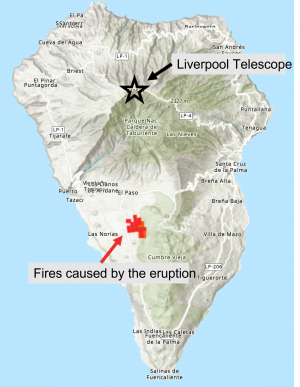Volcanic Eruption on La Palma
Credit - Andrew Newsam
You may have heard that a volcano started erupting on La Palma on 19th September 2021. The Liverpool Telescope is on La Palma but we do not expect any lava to reach the telescope. Staff on La Palma are getting regular updates from local authorities in the area.
[Update]
The telescope has been closed since the 23rd September due to the volcanic ash cloud on La Palma being detected at the observatory.
The situation is currently improving and we hope to start taking observations again soon, but there will be some catching up to do.
The presence of ash at the telescope can change depending on the weather so there may continue to be nights where the telescope remains closed. Please bear with us during this time.
Why is there a volcano erupting on La Palma?
La Palma is one of the Canary Islands. The Canary Islands are a chain of volcanic islands in the Atlantic Ocean. The islands formed over a ‘hot spot’ in the Earth’s mantle. This hot spot made the magma which powers the Canary Island's volcanoes. The last time a volcano erupted on La Palma was in 1971.

Liverpool Telescope and fires caused by the eruption
Credit - NASA (modified by NSO)
How near is the lava to the Liverpool Telescope?
The map shows where the Liverpool Telescope is on the island. It also shows fires caused by heat from the lava. The eruption is taking place 10 miles (16 km) south of the Liverpool Telescope. This is on the other side of the volcano's caldera. Calderas are large holes which form when part of a volcano collapses. This happens because lots of the magma underneath has been released.

